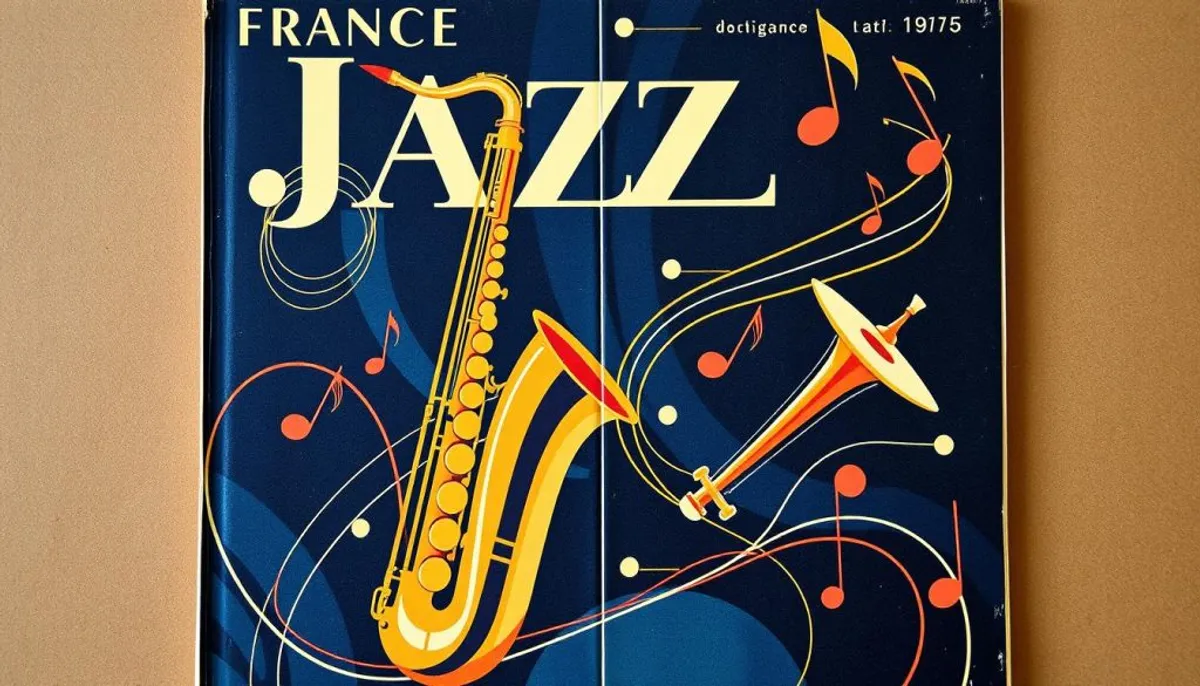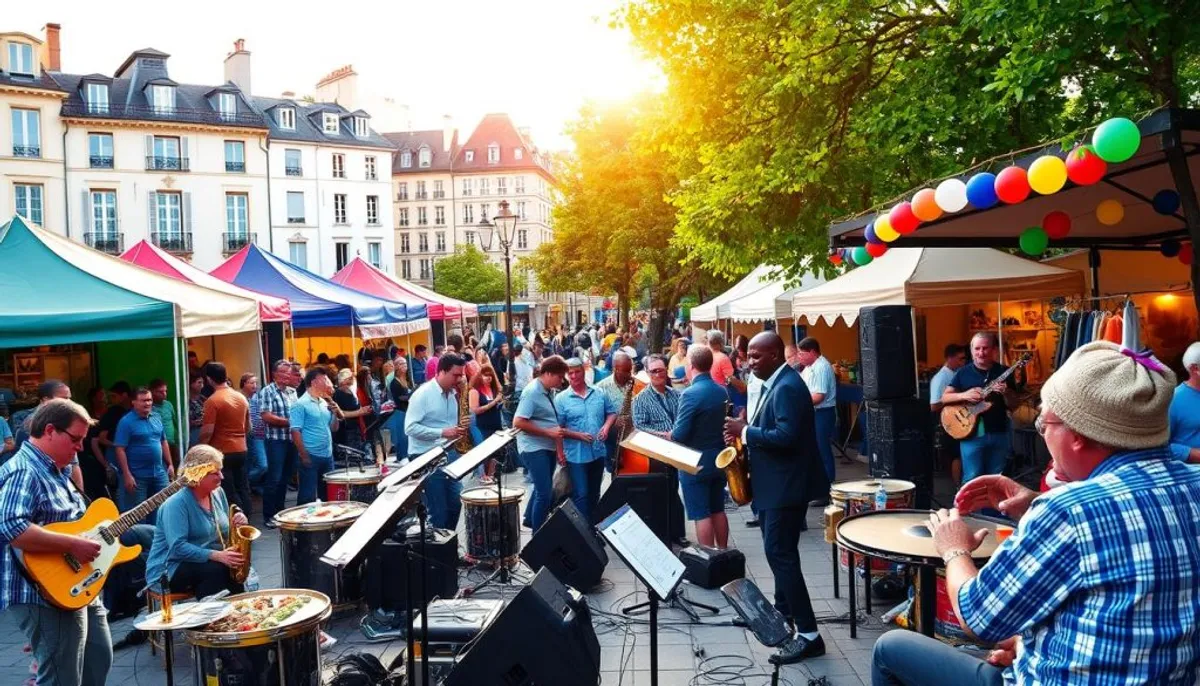The history of French jazz is a rich and complex symphony. Since 1902, the cake-walk marked the beginning of a passion for syncopated rhythms. The First World War brought Afro-American musicians to Paris, injecting new life into the music scene.
The influences of jazz are evident in French composers. Erik Satie introduced ragtime in his ballet “Parade” in 1917. Maurice Ravel, inspired, incorporated elements of blues into his Sonata for violin and piano in 1927.

France became a refuge for many jazz musicians. Sidney Bechet, Bud Powell, and Kenny Clarke found a second home in Paris. This fusion between African-American music and French culture created a unique jazz. This jazz is shaped by passionate intermediaries and iconic venues.
The origins of jazz in France: from cake-walk to hot jazz
The history of jazz in France begins in the early 20th century with the arrival of the cake-walk. This exotic dance, introduced in 1902, marks the start of a new musical era.
The arrival of the cake-walk in 1902
The cake-walk, considered the ancestor of jazz, experienced a meteoric rise in popularity upon its arrival. This African-American dance quickly became popular in Parisian music halls. Its introduction in France coincided with the rise of the United States on the international music scene.
The influence of Afro-American musicians during the First World War
The First World War played a crucial role in establishing jazz in France. Many Afro-American musicians settled in Paris, fleeing racism in the United States. Their music found a warm welcome among the French public, laying the groundwork for the future jazz scene.
The creation of the first French hot clubs
The 1930s saw the birth of the first hot clubs in France. The most famous, the Hot Club de France, was founded in 1932 by Hugues Panassié. These clubs played an essential role in promoting and disseminating hot jazz, a new form of African-American music.
| Year | Event |
|---|---|
| 1902 | Introduction of the cake-walk in France |
| 1914-1918 | Influence of Afro-American musicians during the First World War |
| 1932 | Creation of the Hot Club de France |
| 1935 | Launch of the magazine Jazz Hot |
The role of intermediaries in French jazz culture
Intermediaries have been essential in the formation and promotion of jazz in France. Their impact has shaped the music scene, establishing a link between artists and the public. This role has been crucial for the dissemination of jazz.
Hugues Panassié and the Hot Club de France
In 1932, Hugues Panassié founded the Hot Club de France, a pillar of French jazz. He advocated for a traditional approach, contributing to the recognition of jazz in France. The Hot Club de France became a sanctuary for jazz aficionados.
Charles Delaunay and the Jazz Hot magazine
Charles Delaunay, editor of Jazz Hot, played a key role in the dissemination of jazz. Launched in 1935, the magazine offers reviews, interviews, and musical analyses. Jazz Hot became an indispensable reference for enthusiasts.

Influential critics and producers
Influential figures emerged in the French jazz landscape. Jacques Canetti, an innovative producer, competed with the Hot Club de France. He used radio and his label to promote new talents. To ensure the sustainability of these initiatives, it is essential to define a budget for cultural projects. André Hodeir, a composer and musicologist, brought academic legitimacy to African-American music with his analyses.
These intermediaries have shaped the perception of jazz in France. They influenced public tastes and supported artists. Their work solidified jazz in French culture, creating a unique ecosystem where critics, producers, and musicians work together, while contributing to the entrepreneurial dynamics surrounding this music scene.
The golden age of French jazz (1940-1960)
The period from 1940 to 1960 is considered the peak of post-war French jazz. Paris, becoming the center of European jazz, attracts many international artists. The Parisian clubs, full of creative energy, foster collaborations between French and American artists.
French musicians stand out for their talent and originality. Names like Martial Solal, René Urtreger, and Pierre Michelot gain international recognition. Their work with American legends enriches the French musical landscape. In 1957, a significant event showcases this synergy: Miles Davis improvises the soundtrack for Louis Malle's film “Ascenseur pour l'échafaud,” surrounded by French musicians.
The 1950s mark the height of hot clubs, becoming essential venues for jazz lovers. The first jazz festival in the world takes place in France in 1948, demonstrating the growing enthusiasm for this music. Claude Bolling, influenced by Duke Ellington, leads big bands and excels in film music, embodying the versatility of French jazz.
This excitement attracts an increasingly broad audience, shaping a generation of passionate listeners. Jazz firmly establishes itself in the French cultural landscape, paving the way for the decades to come.
Iconic jazz venues and festivals
France is rich in exceptional venues for the jazz experience. From Parisian jazz clubs to major festivals, as well as contemporary concert halls, the country offers a vibrant and diverse jazz scene.
Historic Parisian jazz clubs
Paris, the birthplace of French jazz, is home to legendary clubs. These venues, with exceptional intimacy, have hosted many famous musicians. Their cozy atmosphere and perfect acoustics make them unique places to enjoy jazz.
Major festivals: Antibes, Marciac, Vienne
Jazz festivals in France attract thousands of enthusiasts every year. Jazz à Vienne, created in 1981, takes place every summer and offers a rich program. Jazz à Juan, in Antibes, celebrates its 60th anniversary in 2020. The Marciac festival, in Gers, has become a must-attend event for international jazz.

Contemporary concert halls
New concert halls continue the jazz tradition in France. The Pelle-Mêle in Marseille and the Instants Chavirés in Montreuil are examples of modern venues. They host innovative jazz concerts, contributing to the vitality of the current jazz scene and inspiring a new way of life.
| Festival | Location | Year Established | Particularity |
|---|---|---|---|
| Jazz à Vienne | Vienne | 1981 | Jam sessions, workshops, exhibitions |
| Jazz à Juan | Antibes Juan-les-Pins | 1960 | Oldest jazz festival in France |
| Jazz in Marciac | Marciac | 1978 | Internationally renowned rural festival |
| Paris Jazz Festival | Paris | 1994 | Over 120,000 spectators annually |
The unique legacy of gypsy jazz
Gypsy jazz, emerging in the 1930s, is a French musical treasure. It merges captivating rhythms, unforgettable melodies, and exceptional improvisations. This fusion creates a distinct sound, recognized everywhere.
Django Reinhardt and the Quintette du Hot Club de France
Django Reinhardt, an icon of gypsy jazz, transformed the jazz guitar. In 1934, he created the Quintette du Hot Club de France with Stéphane Grappelli. Their energetic music captivated a global audience, establishing a unique genre.
The evolution of jazz guitar in France
The gypsy guitar, with its steel strings, becomes central. Unique techniques like the “pompe” and the “hammer” emerge. The repertoire expands, including waltzes, bossa novas, and tangos. The Selmer-Maccaferri guitar becomes the favorite instrument.
Contemporary heirs
Since the 1990s, a new generation continues the legacy of gypsy jazz. Guitarists like Biréli Lagrène, Angelo Debarre, and Stochelo Rosenberg rediscover the genre. The music scene, animated by numerous festivals, embraces this cultural richness. Music schools now integrate the study of this style into their programs.
Gypsy jazz, a product of a rich culture, continues to captivate and inspire. It ensures the sustainability of this French musical gem, reaching musicians and enthusiasts worldwide.
Conclusion
The evolution of French jazz illustrates a deeply rooted musical history. Its beginnings, influenced by Afro-American artists, gave birth to a distinctive style. Gypsy jazz, embodied by Django Reinhardt, has left a lasting mark on the global scene.
The contemporary scene in France remains vibrant, honoring this musical heritage. The festivals in Antibes, Marciac, and Vienne, as well as the Parisian clubs, attract jazz fans from everywhere. This vitality demonstrates the ability of French jazz to transform while keeping its roots.
A new generation of French musicians explores the boundaries of the genre, blending jazz with other styles. This innovation ensures the international sustainability of French jazz, enriching its musical heritage. The future of jazz in France looks promising, guided by the spirit of innovation and respect for traditions.
RelatedRelated articles


